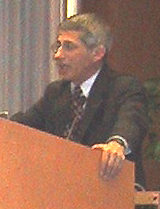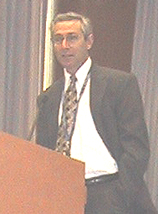

| T H E N I H C A T A L Y S T | M A R C H – A P R I L 2004 |
|
|
|
NEUROIMMUNOLOGY
IN SHOCK AND TISSUE DAMAGE:
|
text
and photos by |
 |
 |
|
NIAID
Director Tony
Fauci (top) and NIMH Director Tom
Insel set the stage for the workshop
|
Advances in neuroscience and immunology that underpin treatment strategies for shock and tissue damage can be quickly adapted to targeted biodefense strategies, investigators agreed at a workshop sponsored by the Integrative Neural Immune Program, NIMH, and NIAID. Other participants hailed from NINDS, NIAAA, NIA, NCI, NCCAM, and the extramural community.
Setting the stage for the business of the workshop, NIAID Director Anthony Fauci described the NIAID Biodefense Research Agenda and emphasized the nationwide infrastructure designed to translate basic research insights into targeted diagnostic, therapeutic, and vaccine strategies for biodefense1,2.
Talking Points
Following are some of the salient issues discussed during the workshop.
![]() NIAID’s Charles
Hackett addressed the rationale for targeting innate immune responses as
a first line of defense against unknown pathogens and supported the focus on
innate immune components for management of shock and tissue damage resulting
from infection or toxins.
NIAID’s Charles
Hackett addressed the rationale for targeting innate immune responses as
a first line of defense against unknown pathogens and supported the focus on
innate immune components for management of shock and tissue damage resulting
from infection or toxins.
![]() Reviewing the role of adenosine and adenosine receptors in shock and tissue
damage, NIAID’s Michail
Sitkovsky highlighted the interplay between hypoxia and adenosine release
in initiating and amplifying shock and tissue damage, as well as the protective
effects of adenosine agonists.
Reviewing the role of adenosine and adenosine receptors in shock and tissue
damage, NIAID’s Michail
Sitkovsky highlighted the interplay between hypoxia and adenosine release
in initiating and amplifying shock and tissue damage, as well as the protective
effects of adenosine agonists.
![]() Joel Linden, of the University of Virginia, Charlottesville, reported on his
studies of adenosine agonists in the treatment of septic shock.
Joel Linden, of the University of Virginia, Charlottesville, reported on his
studies of adenosine agonists in the treatment of septic shock.
![]() NIMH’s Esther
Sternberg reviewed neuroendocrine and neural pathways (hypothalamic-pituitary-adrenal
axis, sympathetic and parasympathetic nervous system, and endocannabinoids)
known to regulate both inflammation and cardiovascular tone in shock and tissue
damage.
NIMH’s Esther
Sternberg reviewed neuroendocrine and neural pathways (hypothalamic-pituitary-adrenal
axis, sympathetic and parasympathetic nervous system, and endocannabinoids)
known to regulate both inflammation and cardiovascular tone in shock and tissue
damage.
![]() Cox Terhorst, of Harvard University, Boston, offered insights from his studies
of experimental colitis.
Cox Terhorst, of Harvard University, Boston, offered insights from his studies
of experimental colitis.
![]() NIAID’s Mahtab
Moayeri presented observations from animal models of anthrax lethal toxin-induced
shock.
NIAID’s Mahtab
Moayeri presented observations from animal models of anthrax lethal toxin-induced
shock.
![]() Jane Welsh, of the University of Texas A&M, College Station, discussed the
glucocorticoid responses in protecting against and exacerbating postviral shock.
Jane Welsh, of the University of Texas A&M, College Station, discussed the
glucocorticoid responses in protecting against and exacerbating postviral shock.
![]() NIMH’s Jeanette
Webster elaborated on glucocorticoid receptor repression by anthrax lethal
toxin.
NIMH’s Jeanette
Webster elaborated on glucocorticoid receptor repression by anthrax lethal
toxin.
![]() NIAAA’s George
Kunos reported on endocannabinoid receptors in septic shock.
NIAAA’s George
Kunos reported on endocannabinoid receptors in septic shock.
![]() Kevin Tracey, of the North Shore–Long Island Jewish Research Institute,
Manhasset, N.Y., explored the role of the vagus nerve and cholinergic agonists
in the treatment of sepsis and shock.
Kevin Tracey, of the North Shore–Long Island Jewish Research Institute,
Manhasset, N.Y., explored the role of the vagus nerve and cholinergic agonists
in the treatment of sepsis and shock.
Dualities
Several common themes emerged from these presentations and the subsequent panel discussion, moderated by NINDS’ Audrey Penn and Richard Johnson, of Johns Hopkins University, Baltimore.
![]() Much like overenhancement of adaptive immunity, overstimulation of innate immunity
is a double-edged sword.
Much like overenhancement of adaptive immunity, overstimulation of innate immunity
is a double-edged sword.
![]() Similarly, mediators that regulate both inflammation and cardiovascular tone
(hypotension) can either protect from or enhance shock and tissue damage.
Similarly, mediators that regulate both inflammation and cardiovascular tone
(hypotension) can either protect from or enhance shock and tissue damage.
![]() As an inducer of mediator release, hypoxia generates more hypoxia and tissue
damage.
As an inducer of mediator release, hypoxia generates more hypoxia and tissue
damage.
![]() Neural and neuroendocrine factors deserve study both as potential molecular
therapeutic targets and as factors contributing to individual variability in
host susceptibility in the general population.
Neural and neuroendocrine factors deserve study both as potential molecular
therapeutic targets and as factors contributing to individual variability in
host susceptibility in the general population.
Directions
It was agreed that several agents already shown to be effective in treating shock and tissue damage in animal models exposed to known pathogens might well be quickly applied to treating shock and tissue damage from unknown biotoxins.
It was also agreed that fully effective management of patients exposed to biotoxins would include evaluation of responsiveness and activity of neural and neuroendocrine pathways that could contribute to individual variability related to age, sex, associated illness, concurrent medications, physical training, stress, nutritional deprivation, and other physiological stressors.
Investigators emphasized
the importance of considering sex hormones and interactions between the hypothalamic-pituitary-gonadal
axis and other neuroendocrine systems as variables that could modulate the effects
of neural agents in the treatment of shock and tissue damage. ![]()
_______________________________________________
1. A.S. Fauci. "Biodefence on the research agenda. Commentary." Nature 421: 787 (2003).
2. NIAID Biodefense Research Agenda for CDC Category A Agents. Progress Report, Aug. 2003: click onto title to download 41-page PDF file of the progress report.
| BIODEFENSE WORKING GROUP AND LISTSERVE |
|
The biodefense workshop served as a platform from which to launch a biodefense working group and interactive LISTSERV. Coordinated by the Integrative Neural Immune Program, the group will share research findings, reagents, potential therapeutic agents, tissues, and access to relevant animal models. A trans-NIH effort that brings together neuroscientists, immunologists, medicinal chemists, and others from multiple institutes, universities, and the FDA, the working group exemplifies the "multdisciplinary research team of the future" envisioned in the NIH director’s research road map. To join the group
and the LISTSERV, contact Socorro Vigil-Scott. |